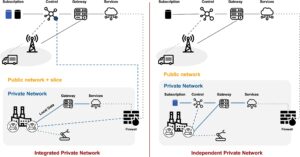Private networks have the potential to change many industries and become the primary application for 5G. Processes and protocols make them work.
Private 5G networks offer dedicated cellular communication to meet the specific requirements of enterprises and organizations. Common use cases include factory automation, warehouse automation, healthcare, campus communications, mining, and transportation. How?
This article explains how private 5G networks operate, highlights their advantages, and outlines various deployment models. It also discusses the importance of network slicing and reviews key applications that benefit most from private 5G networks.
Private network advantages
The 3rd Generation Partnership Project (3GPP) standardizes and maintains the protocols and specifications for private, non-public networks (NPN). In 2020, 3GPP Release 16 introduced updates and features to support the deployment of private 5G networks. Within this framework, the 3GPP TS 22.261 standard establishes detailed criteria for defining these networks.
Private 5G networks offer many advantages over public 5G networks. For example, owners can deliver uninterrupted coverage throughout buildings and across campuses, operate within licensed or unlicensed wireless spectrum bands, and granularly manage network access and functions. Private 5G also bypasses public network congestion, ensuring low latency and high speeds for crucial, time-sensitive applications. Lastly, private 5G networks safeguard sensitive data with end-to-end encryption, a default feature not always available on public 5G networks.
In various scenarios, private 5G networks outperform Wi-Fi by providing broader coverage, higher device capacity, and more effective signal penetration. Unlike Wi-Fi, which often struggles in high-density environments, private 5G networks efficiently manage multiple devices simultaneously without compromising performance. Moreover, dynamic access to licensed and unlicensed wireless spectrum ensures interference-free communication, while low-latency access and robust security measures directly address mission-critical application requirements.
Network architecture and integration
Most devices and endpoints on public 5G networks use public land mobile network (PLMN) IDs to access cellular infrastructure. PLMN IDs, however, require mobile network operators (MNOs) to authorize and facilitate connectivity. Private 5G bypasses MNO intermediaries by establishing a direct, secure connection through standalone non-public network (SNPN) IDs — minimizing latency, streamlining the management of devices and applications, and reducing potential vulnerabilities.

Figure 1. Comparative diagram illustrating two configurations of 5G network deployment: an integrated private network that shares certain resources with a public network, and an independent private network with dedicated infrastructure, highlighting their respective data pathways and control mechanisms (Image: Springer).
Public network integrated non-public networks (PNI-NPNs) play an essential role in bridging private and public 5G networks (Figure 1). Accessible through MNO PLMNs, PNI-NPNs use dedicated data networks (DNNs) located behind 3GPP user plane gateways. This setup separates the user plane function (UPF), the internet protocol (IP) data networks behind the UPF, and the session management function (SMF) controlling the UPF for private network DNNs. Although PNI-NPNs dedicate resources to private network traffic, the networking backbone may still be shared with MNOs and other private networks. To prevent unauthorized use, 3GPP introduced closed access groups (CAGs) in Release 16, ensuring only devices with access credentials can connect to these networks.
Alternatively, the MNO can allocate exclusive slices within 3GPP networks. Each slice features dedicated instances of key components, such as the gNodeB central unit user plane (gNB-CU-UP), UPF, SMF, and IP data networks, all designated exclusively for use by the private network. These slices operate in isolation and employ dedicated IP routes to silo and secure network traffic. Essentially, network slicing creates multiple virtual networks within the same physical infrastructure — each optimizing resource allocation and managing quality of service (QoS) parameters such as capacity and speed for specific devices or applications.
Deployment models for private 5G networks
Although there are many potential configurations, the 5G Alliance for Connected Industries and Automation (5G-ACIA) defines four private 5G deployment models:
- SNPN: This standalone model ensures complete isolation from public networks, offering maximum security and control over private 5G networks.
- PNI-NPN with shared RAN: This model shares part of the radio access network (RAN) with MNOs yet maintains isolation for other essential functions and keeps non-public network data on-site.
- Shared RAN and control plane: In this configuration, both the RAN and control plane functions are shared with the public network, although NPN data remains on-premises. This setup ensures security and control using access point names (APN) or network slicing.
- NPN hosted by public network: Here, the NPN is entirely deployed within the public network infrastructure, leveraging APN or comprehensive network slicing for integration.
Key applications and use cases
Offering reliable coverage, high-speeds, and low latency, private 5G networks support diverse applications across various industries. In areas where laying fiber is impractical, private 5G networks deliver high-bandwidth connectivity to fixed wireless access (FWA) customers. In manufacturing, private 5G is crucial for low-latency operations of assembly line robots, autonomous guided vehicles (AGVs), and scanners. Similarly, private 5G optimizes warehouse operations with time-sensitive networking (TSN) for edge devices, asset tracking, and AGVs.
The end-to-end encryption capabilities of private 5G networks help medical facilities comply with strict data privacy laws, while enabling telemedicine, remote patient monitoring, and real-time data analysis. In hospitality and event venues, private 5G complements Wi-Fi for guests, staff, and infrastructure, linking automated vending machines and edge devices, including cameras and sensors. Private 5G also bolsters campus-wide connectivity, supporting advanced research and immersive learning devices, such as augmented reality (AR) and virtual reality (VR) headsets. Lastly, private 5G facilitates the real-time monitoring and control of critical energy and mining equipment in challenging terrains with limited access to public 5G networks.

Figure 2. A graphical representation of the 5G frequency bands — low-band, mid-band, and high-band (mmWave) — and their respective trade-offs in coverage, capacity, and latency (Image: DgtlInfra).
Ranges and speeds of private 5G networks
Private 5G network ranges vary depending on application requirements and frequency band, spanning a few thousand feet to several dozen miles. Low-band 5G networks, operating below 1 GHz and at sub-300 Mbps speeds, provide expansive coverage over hundreds of square miles for agricultural monitoring and rural internet access. Figure 2 shows the tradeoffs.
Mid-band private 5G networks, operating in the sub-6 GHz range, strike a balance between coverage and speed. They offer several miles of range with low multi-gigabit speeds, making them ideal for internet providers and smart city applications. High-band 5G, also known as mmWave, operates at mid to high multi-gigabit speeds and provides around a mile of high-capacity coverage for public venues, immersive AR/VR experiences, and manufacturing automation.
Summary
In many scenarios, private 5G networks provide improved coverage, capacity, and latency compared to public 5G and Wi-Fi. These networks establish direct connections through SNPN IDs and feature flexible deployment models that seamlessly integrate private and public 5G. Private 5G networks also accommodate a broad range of frequencies to meet the diverse coverage and low latency requirements of various applications, from industry and manufacturing to medical, education, and hospitality.
References
Private 5G: What is it? How Does it Work?, 5G Technology World
Private 5G Networks: A Survey on Enabling Technologies, Deployment Models, Use Cases and Research Directions, Springer
What is Private 5G?, HPE Aruba Networking
Should You Build a Private 5G or LTE Network?, Sierra Wireless
What is Private 5G Network?, Cisco
What is private 5G?, RedHat





Tell Us What You Think!